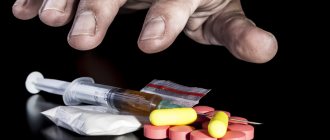Prices for drug lawyer services
Amphetamine is a psychotropic substance that stimulates the central nervous system. It is sold in the form of powder, tablets or capsules and is used mainly by clubbers. The drug relieves fatigue, gives a surge of strength and energy, but subsequently leads to mental and physical exhaustion, causing irreparable harm to the psyche and internal organs. Its storage, transportation and use are prohibited by Russian legislation.
What is drug possession?
Possession of amphetamine is the actual possession, possession of this prohibited psychotropic substance. Its duration and location do not matter. Psychotropic drugs may be in the possession of people who regularly or periodically use them, drug couriers, manufacturers or other participants in illicit business.
The elements of the crime and responsibility for it are covered by Article 228 of the Criminal Code of the Russian Federation and decisions of the Supreme Court. Regulatory legal acts cover all possible cases of storage of narcotic drugs:
- on you (in your pocket, bag, etc.);
- indoors (at home, with friends, etc.);
- in a specially created cache.
Once the amphetamine is placed at its intended location, the crime is considered over: i.e. its formal composition takes place.
01
Free consultation with a drug lawyer
02
Free hotline (Moscow and regions of the Russian Federation)
8 800 707 84 52 03
Consultations in a mobile application
Prices for drug lawyer services
The qualification of an illegal act is not affected by why a person kept drugs: for his own use or further resale. However, in the first case, the defendant will face a less severe punishment, because further sale of psychotropic drugs is recognized as an aggravating circumstance.
Symptoms and signs of amphetamine use
The more severe the addiction, the more difficult it is to hide. In the case of amphetamine addicts, signs of use are noticeable within several hours after starting to take the substance - such is the strong impact it has on the psyche.
Physical signs of amphetamine use
- disturbance and sometimes complete loss of appetite;
- sudden weight loss (sometimes up to 10 kg is lost within a week);
- increased sweating;
- sleep disorders;
- loss of the body's immune properties;
- constant dry mouth, severe thirst;
- excessive craving for sweets.
The combination of these signs suggests that the person most likely has begun to develop an amphetamine addiction.
External signs of amphetamine use
- pale dry skin;
- brittle hair, early baldness;
- unsteady gait, loss of coordination;
- yellow crumbling teeth;
- unkempt appearance;
- complete disregard for personal hygiene rules.
As a result, a person’s vocabulary is sharply limited, but unusual slang words appear in their speech. He completely changes his social circle and behaves strangely and unpredictably with his family.
Pupils under the influence of amphetamine
The pupils of an amphetamine addict are dilated and do not react to light. The whites of the eyes are covered with a red vascular network. The gaze becomes absent, as if “glassy”.
Changing the behavior of an amphetamine addict
Since amphetamine has a powerful stimulating effect on the central nervous system, the addict’s behavior becomes impulsive, he is overly emotional and unbalanced. The euphoric effect of taking amphetamine is an increased concentration of attention and mental abilities, which is why students often use the drug during a session.
Amphetamine increases libido - young people in a state of drug intoxication can have sex for several hours without physiological release.
Under the influence of the drug, a person can perform painstaking, monotonous and meaningless work for a long time, which he forgets about immediately after the amphetamine stops affecting the body.
The drug addict avoids his previous social circle; he constantly has urgent matters and excuses for not being close to loved ones.
As soon as the effect of the drug wears off, the person becomes completely indifferent, lethargic, and emotionally devastated.
Other signs that appear from the central nervous system:
- excessive talkativeness;
- unjustified self-confidence;
- unproductive physical activity;
- anxiety;
- delusions, hallucinations;
- insomnia.
What factors does the court consider?
If you are dealing with a legal case involving the possession and use of amphetamine, remember that each case is unique and individual. In addition to the legislative framework, you need to familiarize yourself with existing judicial practice and take into account all the subtleties and details. A positive outcome depends on many factors.
During the trial, law enforcement officers must determine why the person kept the amphetamine: for personal use or for sale. The following circumstances speak in favor of the second option:
- the defendant does not practice drug use;
- amphetamine was found in large quantities;
- the psychotropic substance was packaged in containers convenient for further resale.
During the trial, the size of the substance found is taken into account. This is the parameter based on which the servants of the law attribute the case to a specific part of Article 228. Three options are possible:
- significant size – more than 0.2 g of the drug was found on the suspect;
- large – a person stored more than 1 gram;
- especially large – we are talking about a mass of 200 g.
Important! The law speaks specifically about the mass of a pure substance. Impurities necessary for storing and transporting the drug (chalk, flour, etc.) do not increase the size.
The second important factor taken into account during judicial review is volume. This is a subjective characteristic that affects the severity of the punishment. Thus, a weight of 0.25 g and 0.99 g belongs to the “significant size” category. However, it would be unfair to assign equal liability for different amounts of prohibited substances. The court will take this factor into account when determining the prison term or fine amount.
To whom is Amphetamine absolutely contraindicated?
In many cases, deadly consequences from Amphetamine are possible after the first dose:
- Diseases of the heart and blood vessels. If you have cardiovascular problems, the first dose may cause a heart attack.
- Head injuries. When pressure increases, previously damaged blood vessels in the brain may rupture.
- Mental disorders. Amphetamine stimulates mental activity and aggravates mental disorders: sudden outbursts of rage towards others, suicide after prolonged depression, an accident against the background of hallucinations and panic attacks are possible.
- Addiction to alcohol. The combination of a stimulant with ethanol puts a tremendous strain on the heart and provokes an acute attack.
- Drugs for depression. Amphetamine and antidepressants are an unusually toxic combination for the brain.
Liability for possession of amphetamine derivatives
The penalties applied for possession and use of a psychotropic substance depend on the amount of the drug found. If it is less than 0.2 g, there is no criminal liability. The provisions of Article 6.8 of the Code of Administrative Offenses of the Russian Federation are used against the accused. This is an administrative arrest (for a maximum of 15 days) or a fine of 4-5 thousand rubles. If prohibited drugs are found on a foreign citizen, he will be expelled from Russia.
The legislation leaves the accused with methods to exclude administrative liability for using a prohibited drug. To do this, he needs to go to a specialized center for drug addiction treatment. If the case is being heard in court, a written request must be submitted.
Possession of the drug in a significant amount carries more severe penalties. This:
- a fine of up to 40 thousand rubles;
- deductions from wages for a three-month period;
- compulsory or correctional labor;
- imprisonment for three years.
If the crime is committed on a large scale, the only possible punishment is imprisonment for a period of 3-10 years. This measure of liability may be supplemented by a fine of up to half a million rubles, deductions from wages for a three-year period, or restriction of freedom for a year. The decision on the need for these “surcharges” is made by the court.
For cases on a particularly large scale, the penalty is imprisonment for 10-15 years. This measure may be supplemented by a fine of up to 500 thousand rubles, deductions from wages for three years, or restriction of freedom for 1.5 years.
Important! Provisions of Art. 228 apply to any activity related to amphetamine. The “article” includes its acquisition (purchase, discovery, receipt as a gift) for the purpose of use or resale, transportation, storage, production.
How does the drug Amphetamine work?
Once in the body, it stimulates the production of two important neurotransmitters - the “hormone of vivacity” adrenaline and the “hormone of happiness” dopamine. It is because of the influence of these neurotransmitters that characteristic drug intoxication manifests itself:
- A powerful surge of vigor, a thirst for active movements.
- Increased physical endurance and strength.
- Active wakefulness for 1-3 days without sleep.
- Improving memory and analytical abilities.
- Reduced need for food.
- Looseness, talkativeness.
- Sharpening of perception.
- Loss of sense of time.
- Visual and auditory hallucinations.
- Loss of coordination, manic repetition of meaningless movements.
How to mitigate the punishment?
Art. 228 of the Criminal Code of the Russian Federation leaves citizens who transport, use, or purchase amphetamine the right to avoid criminal liability. To do this, you need to voluntarily hand over the prohibited powder to the internal affairs authorities. It must be brought to the department of one’s own free will, and not given out at the time of the search or after the start of investigative measures.
Unconditional assistance to the investigation provided by a person guilty of possession of amphetamine is exempt from severe punishment. It must name the accomplices in the illegal actions and indicate the property obtained illegally. This must be done before the arrest, then a criminal case will not be brought against the guilty person.
Author of the article
Dmitry Leonov
Work experience 15 years, specialization - housing, family, inheritance, land, criminal cases.
Author's rating
721
Articles written
712
about the author
Useful information on drugs
- Possession of narcotic drugs
- Sale of narcotic drugs
- Term for selling drugs
- Article for drug distribution
- Transportation of drugs
- Drug smuggling
- Punishment for drug use
- Organizing a drug den
- Manufacturing of narcotic drugs
- Punishment for possession of amphetamine
- Ephedrine is a criminal offense
- Punishment for growing weed
- Snus what is it? Is it banned in Russia? Harm of snus and consequences
Methods of using amphetamine
Snort, inject, swallow, rub into the gums, smoke - amphetamine is used in different ways, depending on the form of release. To achieve a narcotic effect, there is no difference in how you take amphetamine - it is equally destructive.
- The white or gray powder is mostly smoked, snorted or injected.
- Tablet forms are taken orally (most often distributed in clubs).
- Fen-herb, mistakenly considered a weak drug, is sold in tablet form in clubs and party places.
- Liquid amphetamine is injected or used for further crystallization.
- Green, blue, blue, brown amphetamine crystals are not a marketing gimmick, but a convenient way to distribute them in the form of bath salts.
It is highly likely that your loved one is under the influence of amphetamine if the following signs appear:
- Dilated pupils, glassy eyes, red whites of the eyes.
- Rapid tooth decay (up to 5 teeth per day) due to calcium loss.
- Inhaling or smoking amphetamine damages the mucous membrane, bronchi, and lungs, so coughing is a harbinger of many pathologies of the respiratory system.
- Behavior change. Excessive activity and emotionality, increased libido, fruitless monotonous activity that does not obey logic, loss of sleep and appetite - all this is the result of the effects of amphetamine. After its effect ends, the person becomes indifferent, even apathetic, and panic attacks and hallucinations are possible.
What are the dangers of taking a hair dryer to your sexual health?
The influence of amphetamine on potency only at the initial stage has an imaginary positive effect. If a person takes a drug to obtain more acute sensations during intimacy, then it should be taken into account that the substance has this effect in 80% of cases. And in the rest, no sexual activity is observed, and regular use causes a sharply opposite effect.
A person who constantly takes amphetamine will definitely face the following consequences:
- decreased attraction to the opposite sex;
- functional erectile dysfunction, which can lead to impotence;
- difficulties in achieving orgasm or lack thereof;
- untimely ejaculation: premature or prolonged;
- deterioration in sperm quality, up to the inability to fertilize.
Promiscuous intimate contacts several times increase the risk of contracting AIDS, hepatitis and other infectious diseases that are sexually transmitted.
Amphetamine and potency are incompatible concepts. Because after 2-3 months of regular use of the stimulant, the addict loses the ability to receive pleasure from anything, including sexual intimacy. And if we add to this problems with erection and ejaculation, then we can say with full responsibility that the hair dryer has a detrimental effect on intimate life.
Symptoms and signs of withdrawal from amphetamine drugs
Withdrawal syndrome (withdrawal or withdrawal in the slang of drug addicts) occurs if the addict cannot get the desired dose for a long time or he decides to stop taking amphetamine on his own.
Abstinence occurs in several stages:
- "Hit". These are the first hours and days after the last amphetamine intake. The symptoms of withdrawal syndrome are especially pronounced: a person experiences a state of psychosis, depression, unjustified aggression, increased anxiety and other mental disorders. At these moments he is unable to think about anything other than the next dose, and, as a rule, he cannot stand it and breaks down.
- Gradually, severe withdrawal symptoms subside. Within 7-10 days, the craving for drug use decreases, the emotional background stabilizes, and behavior returns to relative normality. Sleep is restored, anxiety disappears. During this period, it is necessary for someone to be nearby and provide the addict with full support, since at times the person will feel the need for the drug.
- The desire to take the drug practically disappears, but the craving does not disappear completely. A breakdown is possible in stressful situations or during communication with former “friends” who continue to use.
Is it possible to quit using amphetamine on your own?
Narcologists are unanimous in answering this question: no, it is impossible to get rid of addiction on your own. Unfortunately, amphetamine is addictive in a very short time; after almost 1-2 doses, a person will experience a psychological craving, which after a couple of months develops into physical dependence.
During this time, the drug will do its job: the addict’s baggage will include impaired mental and physical health, loss of familiar relationships.
A huge mistake made by loved ones of a drug addict is turning to all sorts of healers, healers, clairvoyants, reading prayers and conspiracies. Remember that this is a waste of precious time - in the case of amphetamine, the count is literally days.
In such a situation, it is important not to hesitate and begin professional treatment as quickly as possible.
Do tests show the presence of amphetamine in the body?
Even after a single use, amphetamine does not leave the body for a long time. To determine its presence in tissues and liquids, test strips are used, which can be freely purchased at pharmacies. Urine is used for rapid analysis. With a single dose, amphetamine is detected 3-4 days after administration.
Laboratory analysis is more accurate - it shows not only the presence of the drug, but also the frequency of use.
In a clinical setting, blood is drawn for analysis. Systematic use of amphetamine will retain it in the body for about 3 weeks.
History of creation
Amphetamine was invented in Romania by researcher Lazar Edeleanu in 1887. Use for medical purposes dates back to 1920, when Gordon Allen resynthesized and studied the substance. In 1933, the first inhaler based on it, Benzedrine (Smith, Kline and Frenc), appeared on the pharmaceutical market.
The pharmacokinetics of the drug attracted the attention of the military. Amphetamines were widely used in the armies of the USSR, America, Germany, and Japan. The experience of large-scale use made it possible to identify the heavy narcotic properties of the substance, and therefore restrictions were gradually introduced.
Currently, synthesis is predominantly illegal. Russia has placed the drug on Schedule I of controlled substances, the use of which is permissible only for research purposes.
According to EMCDDA data, in 2022, almost 12 million people in the European Union aged 15 to 65 years old used amphetamine at least once.
Literature:
- Pyatnitskaya, Irina Nikolaevna. General and private narcology / I. N. Pyatnitskaya. - Moscow: Medicine, 2008. - 637, [1] p.; 22 cm. - (Guide for doctors).; ISBN 5-225-03329-6 (translated)
- Novichkova, Yulia Nikolaevna. Reasons for the development and clinical manifestations of alcohol disorders and drug addiction [Text]: educational manual / Yu. N. Novichkova; National Health Institution “Scientific Clinical, Center for Postgraduate and Professional Education, Department of Additional Professional Education of Secondary and Junior Medical Personnel. - Moscow: Max Press, 2022. - 81 p. : ill., table; 21 cm; ISBN 978-5-317-05954-5
- Man. Life and health: the most complete encyclopedia / [Katherine Anderson et al. lane from English V.V. Maslova]. - Moscow: AST: Astrel, 2009. - 479 p. : ill., map., table; 22 cm; ISBN 978-5-17-055332-7 (translated)
- Gorskaya I.Yu. Bad habits and their prevention [Electronic resource]: textbook / comp. Gorskaya I.Yu., comp. Gubareva N.V. - Omsk: Publishing house SibGUFK, 2010. - 212 p.
Amphetamine overdose
The most dangerous consequences of an overdose are acute renal failure, metabolic acidosis, and pulmonary edema. Each of these consequences can be fatal and cause cardiac arrest.
The main signs of overdose:
- dilated pupils;
- high blood pressure;
- cardiopalmus;
- increased body temperature;
- deathly pale skin;
- impaired coordination of movements;
- unpredictable aggressive behavior, delusions, hallucinations.
If possible, the person should be given first aid: restrict movement, turn on his side, give plenty of fluids, and be sure to call an ambulance. A person with an overdose should not be left alone: since he is not adequate, he can harm himself or others.
Content:
- How does a hair dryer work?
- How does amphetamine affect potency?
- What are the consequences of using a psychostimulant?
- What are the dangers of taking a hair dryer to your sexual health?
- How to restore potency after amphetamine
Therefore, among the main consumers of this drug are young people aged 15-36, who are captivated by its low cost and quick stimulating effect. Under the influence of the first doses of the drug, a person is able to go for a long time without food or rest, and perform the most difficult work and creative tasks. He feels like a super lover with inexhaustible sexual activity. Having experienced such feelings, boys and girls fall into drug networks and want to feel such euphoria again.
At the same time, few people at the initial stage think about the other side of addiction to a psychoactive drug: how amphetamine affects potency and, in general, physical and mental health. Only with time comes an understanding of the negative impact of the drug, when it is already impossible to overcome the addiction without medical help.
Consequences of amphetamine use
Aggression, paranoid psychosis, hallucinations are just a small part of the terrible consequences of amphetamine use. Systematic drug use leads to vegetative-vascular disorders, physical exhaustion, and pathological destruction of personality. A frequent companion to amphetamine addiction is psychosis, which has symptoms similar to schizophrenia. Often, chronic use leads to a point of no return, when it ends in painful death or a lifelong stay in a psychiatric clinic.
Meanwhile, drug experts highlight the short-term and long-term consequences of amphetamine use.
Short term consequences
A single or short-term use of amphetamine causes nervousness, irritability, increased sweating, headaches and joint pain, cough, and fever. Symptoms largely depend on the person's current health status.
An increased dose of amphetamine leads to disturbances in blood pressure and circulation, and rapid heartbeat. In men, temporary disturbances in the sexual sphere are possible.
An increased dose leads to more serious consequences: hallucinations, circulatory failure, heart and kidney failure, loss of consciousness, hyperemia, which is life-threatening.
Long-term consequences
Systematic use of amphetamine leads to insomnia, vascular pathologies, physical exhaustion, skin inflammation, hypertension, and persistent abdominal pain.
Amphetamine has a negative effect on the immune system, so addiction is accompanied by frequent colds.
Various psychoses are another consequence of addiction, dangerous both for the addict and for the people around him.
Long-term use of amphetamine damages the mucous membranes of the mouth, nose, stomach, and destroys the nasal septum.
Chronic addiction increases the risk of sudden strokes and heart attacks. Early, painful death is the logical outcome for amphetamine addicts who do not seek medical help.
How long does amphetamine stay in the body?
It is difficult to give an unambiguous answer - the rate of elimination of amphetamine from the body is influenced by the quality and type of drug, frequency of use, and individual characteristics of the body.
Rate of elimination of amphetamine from the blood
Narcologists use the term “half-life.” This time for removing half of the substance taken from the body is about 10-12 hours. With one-time consumption, amphetamine completely disappears from the blood within a day.
Long-term use is characterized by an accumulation effect, so tests will show the presence of amphetamine in the blood after 10-20 days. Antibodies to amphetamine can remain in the blood for up to 4 months.
Rate of elimination of amphetamine from the blood
Urine is the main biomaterial for detecting amphetamine in the body. A single use keeps amphetamine in the body for up to 10 days; with systematic use, it can be detected even 4 months after stopping use.
Rate of amphetamine removal from other biomaterials
The drug also accumulates in tissues less traditional for analysis. Here is the approximate time for its detection after a single dose:
- saliva - 5 days;
- sweat - 10 days;
- hair - up to 20 days;
- nails - 45 days;
- breast milk - 3 days.
How long do amphetamine addicts live?
There are no exact statistics regarding the life expectancy of amphetamine addicts. It all depends on the volume of the dose, the frequency of use, the quality of the drug, and the individual characteristics of the body. We can talk about averaged data summarizing the experience of narcologists.
The longer a person takes amphetamine, the more tolerance to the substance develops. This means that the addict gradually increases the dose to achieve the usual euphoric effect. The psyche and internal organs experience extreme stress, the body wears out and gradually refuses to function normally. Hepatitis and HIV are companions of injection drug addiction. Together, these factors determine the life expectancy of a drug addict, usually no more than 5-8 years from the start of systemic use.





